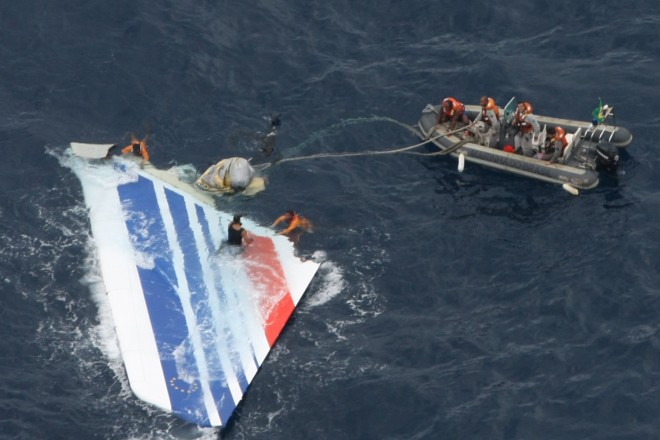AirAsia flight has parallels with 2009 Air France ocean crash

In this June 8, 2009, file photo released by Brazil’s Air Force, Brazil’s Navy sailors recover debris from Air France Flight 447 in the Atlantic Ocean. It took nearly two years to find the black boxes from the missing flight. AP
PARIS—The jet dropped from the sky swiftly, without a mayday call. It was quickly swallowed up by the waves.
It took nearly two years to find the black boxes from Air France Flight 447, but the Rio de Janeiro to Paris flight that fell into the Atlantic Ocean in the early hours of June 1, 2009, could offer insight into what may have gone wrong on AirAsia’s Flight QZ8501. Both flights killed everyone on board, both were flying into storms when they disappeared, and—in both cases—it seemed to the pilots of the Airbus that a climb was the way out of their predicament.
In the Air France flight, several factors converged to bring the plane down: The three pilots of the Airbus A330 were confused by faulty air-speed data after key sensors iced over. Then, about 25 minutes into turbulence, the autopilot and autothrust cut out, and the pilot at the controls began a steep climb, despite requests from the co-pilot in the cockpit to descend.
The captain, who had been away from the cockpit, returned about 90 seconds after the first stall warnings sounded. Four minutes and 23 seconds after the first alarms sowed panic and confusion over how to regain control of the aircraft, the plane slammed into the ocean, plummeting belly first at nearly 11,000 feet per minute. The wreckage was found 12,800 feet beneath the sea, its black boxes intact.
Above the Java Sea, the pilot of the AirAsia Airbus A320 told air traffic control he was approaching threatening clouds, but he was denied permission to climb to a higher altitude. The plane lost contact minutes later. Search teams have not yet found the black boxes containing the same crucial information that pinpointed the causes of the Air France flight.
Article continues after this advertisementInvestigators from the French agency BEA, which investigated that 2009 crash, are in Indonesia. Sonar images have identified what appeared to be large parts of the plane, and the waters are far shallower than they were for the Air France crash, no more than about 100 feet. However, the search has been complicated by strong currents moving the debris.
Article continues after this advertisementThe 2009 crash ended up being, at least in part, a lesson in the hazards of automation. During that time, deprived of autopilot, the panicking men flying the Air France flight took actions that made matters worse, including trying to carry out different maneuvers simultaneously from both sets of controls. Since then, many have cautioned that pilots are often ill-equipped to take over when things go wrong.
“We see more-sophisticated automation in the cockpit really serves us well, and by and large it creates a safer environment for airline passengers. But there are times when that automation can become confusing, or there can be a disconnect between the pilots and the automation in the aircraft,” said Deborah Hersman, former chair of the US National Transportation Safety Board and now president of the National Safety Council, a private advocacy group in the US.
David Greenberg, a former Delta Air Lines executive who was hired at Korean Air to oversee pilot training and safety, said aircraft manufacturers, airlines and the FAA embraced the idea that automation could make flying safer, but more recently began to worry about the times when automation can’t carry the day.
“The focus started to shift back to being capable of using the automation as an assist to reduce workload in the right circumstance, but being capable also of taking over and flying the old way,” Greenberg said.
“In Asia, it’s very normal to rely, in my view, excessively on automation,” he said, “partly because the manufacturers stress that the airplanes are easy to learn and easy to train on and very safe because the automation narrows the gap between skill and required skill.”
RELATED STORIES
2 large objects found in AirAsia wreckage hunt
Doomed AirAsia flight schedule unauthorized—Indonesian transport exec